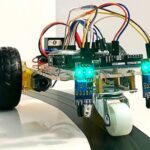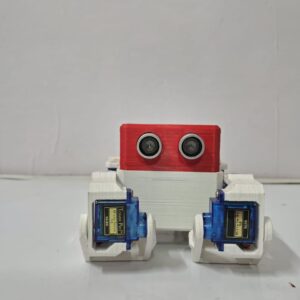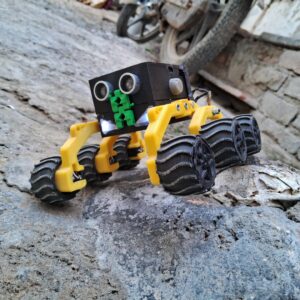Description
Long Description:
An Obstacle Avoidance Robot is an autonomous robot capable of detecting and avoiding obstacles in its path. This type of robot uses sensors like ultrasonic or infrared to identify objects in its vicinity and adjusts its movement accordingly. The robot is controlled by a microcontroller (such as Arduino or ESP32) that processes sensor data and uses a motor driver to control the direction and speed of its motors. This project is widely used in educational robotics, hobby projects, and robotics competitions as it demonstrates basic automation and reactive decision-making.
- Ultrasonic Sensor (Obstacle Detection): The ultrasonic sensor is the main component for detecting obstacles. It works by emitting ultrasonic sound waves and measuring the time it takes for the echo to return. The sensor calculates the distance to an object based on the speed of sound. If an obstacle is detected within a certain range, the sensor sends a signal to the microcontroller to avoid the obstacle. A popular choice is the HC-SR04 ultrasonic sensor.
- DC Motors: The robot is driven by two DC motors that control the movement of the wheels. These motors allow the robot to move forward, backward, and steer left or right. The microcontroller adjusts the speed and direction of the motors based on sensor input, allowing the robot to avoid obstacles by altering its path.
- Motor Driver (L298N or L293D): A motor driver is required to control the DC motors, as the microcontroller alone cannot provide sufficient current to drive the motors. The L298N or L293D H-Bridge motor driver is commonly used, as it allows the microcontroller to control the direction and speed of the motors independently. This setup enables the robot to make sharp turns and navigate around obstacles by controlling each motor separately.
- Microcontroller (Arduino, ESP32, etc.): The microcontroller serves as the brain of the robot. It receives input from the ultrasonic sensor and processes the data to make decisions. If an obstacle is detected within a certain distance, the microcontroller calculates the best direction to move (e.g., turn left, turn right, or reverse). An Arduino is typically used due to its simplicity and wide availability, but other microcontrollers like the ESP32 can also be used for more advanced features.
- Algorithm (Obstacle Avoidance Logic): The microcontroller runs a basic obstacle avoidance algorithm. The algorithm continuously monitors the distance to obstacles using the ultrasonic sensor. If no obstacle is detected, the robot moves forward. When an obstacle is within a set range, the robot stops, reverses, or turns to avoid the obstacle. The algorithm can be modified to incorporate different behaviors, such as slowing down when approaching an obstacle or following a predefined path.
- Power Supply: The robot is powered by a battery pack, typically using rechargeable Li-ion batteries or AA batteries. The power supply provides the necessary voltage for both the motors and the control circuitry. A well-chosen power source ensures that the robot can operate for a reasonable amount of time without interruption.
- Chassis: The robot’s chassis is the physical structure that holds all components together. It typically consists of a platform with wheels, spaces for the motors, sensors, and battery. The chassis can be a DIY design or a pre-made kit, depending on the complexity and scale of the project.
How It Works:
- The robot moves forward in search of a clear path.
- The ultrasonic sensor emits sound waves and listens for the echo to detect obstacles.
- If the sensor detects an obstacle within the preset range (e.g., 10 cm), it sends a signal to the microcontroller.
- The microcontroller processes the signal and instructs the motor driver to stop or change the direction of the motors (e.g., turn left or right) to avoid the obstacle.
- Once the path is clear, the robot continues moving forward.
- This process repeats continuously as the robot navigates through its environment.
Applications:
- Educational Robotics: This project is ideal for teaching robotics and automation, as it involves sensor integration, motor control, and decision-making.
- Home Automation: Robots with obstacle avoidance can be adapted for cleaning or surveillance purposes.
- Robotics Competitions: Obstacle avoidance is a common challenge in robotics competitions, and this type of robot is perfect for practicing and competing.
- Exploration: Obstacle avoidance robots can be used for exploring unknown or hazardous areas without human intervention.
Advantages:
- Autonomous Navigation: The robot can navigate its environment independently, without any manual input.
- Reactive Behavior: The robot can make real-time decisions based on sensor input, allowing it to respond dynamically to changes in its environment.
- Versatile Application: The same basic structure can be expanded with additional sensors, such as infrared or bump sensors, for more complex obstacle detection and avoidance.
In summary, the Obstacle Avoidance Robot is a fun and educational project that demonstrates the core principles of robotics, including sensor-based control, decision-making, and autonomous movement. It’s widely used in robotics courses, competitions, and hobby projects, making it a great starting point for anyone interested in robotics and automation.









Reviews
There are no reviews yet.